Himawari-8/AHI Aerosol Optical Depth Detection Based on Machine Learning Algorithm
Abstract
:1. Introduction
2. Study Area and Data Sources
2.1. Study Area
2.2. Datasets
2.2.1. Himawari-8/AHI Data
2.2.2. ECMWF Reanalysis v5 (ERA5) Data
2.2.3. AERONET AOD Data
2.2.4. Terra/MODIS and Aqua/MODIS AOD Data
3. Model and Methodology
3.1. Data Preprocessing
3.2. Feature Selection
3.3. DNN Model
3.4. Hyperparameter Tuning and Model Validation
4. Results and Discussion
4.1. Overall and Hourly Validation on Sites
4.2. Evaluation of Spatial Distribution on a Regional Scale
4.3. Seasonal Modeling and Validation
4.4. Impact of Meteorological Features
5. Conclusions
- (1)
- The DNN model has a great potential in hourly AOD retrieval for Himawari-8 satellite in China. Based on the validation against AERONET AOD, the accuracy of DNN-estimated AHI AOD with R2 of 0.8702 and RMSE of 0.1326 is much higher than that of the AHI AOD product with R2 of 0.4869 and RMSE of 0.2917. Especially, the DNN model can improve the performance of AHI AOD retrieval in the early morning and in the late afternoon.
- (2)
- For the spatial distribution, DNN-estimated AHI AOD is more consistent with the MODIS AOD product than the AHI AOD product. Therefore, our AOD results can detect air pollution regions with high AOD levels well and can accurately capture hourly variations of aerosol loadings on the regional scale.
- (3)
- For the proposed algorithm framework, meteorological features (i.e., sp, t2m and ws) were involved into the DNN model training, which are not used in the physical AOD retrieval methods based on the atmospheric radiation transferring model. With consideration of the meteorological features, the R2 of DNN-estimated AHI AOD increases by 10.47%, and the RMSE decreases by 14.82%. Among all the meteorological factors, sp has the greatest influence on the AHI AOD estimation.
Author Contributions
Funding
Data Availability Statement
Acknowledgments
Conflicts of Interest
References
- Xue, Y.; He, X.; Xu, H.; Guang, J.; Guo, J.; Mei, L. China Collection 2.0: The aerosol optical depth dataset from the synergetic retrieval of aerosol properties algorithm. Atmos. Environ. 2014, 95, 45–58. [Google Scholar] [CrossRef]
- Lanzaco, B.L.; Olcese, L.E.; Palancar, G.G.; Toselli, B.M. An improved aerosol optical depth map based on machine-learning and MODIS data: Development and application in south America. Aerosol Air Qual. Res. 2017, 17, 1623–1636. [Google Scholar] [CrossRef] [Green Version]
- Qin, K.; Wang, L.; Wu, L.; Xu, J.; Rao, L.; Letu, H.; Shi, T.; Wang, R. A campaign for investigating aerosol optical properties during winter hazes over Shijiazhuang, China. Atmos. Res. 2017, 198, 113–122. [Google Scholar] [CrossRef]
- Oh, H.J.; Ma, Y.; Kim, J. Human inhalation exposure to aerosol and health effect: Aerosol monitoring and modelling regional deposited doses. Int. J. Environ. Res. Public Health 2020, 17, 1923. [Google Scholar] [CrossRef] [Green Version]
- Zeydan, Ö.; Wang, Y. Using MODIS derived aerosol optical depth to estimate ground-level PM2.5 concentrations over Turkey. Atmos. Pollut. Res. 2019, 10, 1565–1576. [Google Scholar] [CrossRef]
- Di Nicolantonio, W.; Cacciari, A.; Petritoli, A.; Carnevale, C.; Pisoni, E.; Volta, M.L.; Stocchi, P.; Curci, G.; Bolzacchini, E.; Ferrero, L.; et al. MODIS and OMI satellite observations supporting air quality monitoring. Radiat. Prot. Dosim. 2009, 137, 280–287. [Google Scholar] [CrossRef]
- Handschuh, J.; Erbertseder, T.; Schaap, M.; Baier, F. Estimating PM2.5 surface concentrations from AOD: A combination of SLSTR and MODIS. Remote Sens. Appl. Soc. Environ. 2022, 26, 100716. [Google Scholar] [CrossRef]
- Jackson, J.M.; Liu, H.; Laszlo, I.; Kondragunta, S.; Remer, L.A.; Huang, J.; Huang, H.-C. Suomi-NPP VIIRS aerosol algorithms and data products. J. Geophys. Res. Atmos. 2013, 118, 12673–12689. [Google Scholar] [CrossRef]
- Du, W.; Qin, Z.; Fan, J.; Zhao, C.; Huang, Q.; Cao, K.; Abbasi, B. Land surface temperature retrieval from Fengyun-3D Medium Resolution Spectral Imager II (FY-3D MERSI-II) data with the improved Two-Factor Split-Window algorithm. Remote Sens. 2021, 13, 5072. [Google Scholar] [CrossRef]
- Diner, D.J.; Beckert, J.C.; Reilly, T.H.; Bruegge, C.J.; Conel, J.E.; Kahn, R.A.; Martonchik, J.V.; Ackerman, T.P.; Davies, R.; Gerstl, S.A.W.; et al. Multi-angle Imaging SpectroRadiometer (MISR)—Instrument description and experiment overview. IEEE Trans. Geosci. Remote Sens. 1998, 36, 1072–1087. [Google Scholar] [CrossRef]
- Goloub, P.; Tanre, D.; Deuze, J.L.; Herman, M.; Marchand, A.; Breon, F.-M. Validation of the first algorithm applied for deriving the aerosol properties over the ocean using the POLDER/ADEOS Measurements. IEEE Trans. Geosci. Remote Sens. 1999, 37, 1586–1596. [Google Scholar] [CrossRef]
- Geogdzhayev, I.V.; Mishchenko, M.I.; Rossow, W.B.; Cairns, B.; Lacis, A.A. Global two-channel AVHRR retrievals of aerosol properties over the ocean for the period of NOAA-9 observations and preliminary retrievals using NOAA-7 and NOAA-11 data. J. Atmos. Sci. 2002, 59, 262–278. [Google Scholar] [CrossRef] [Green Version]
- Veihelmann, B.; Levelt, P.F.; Stammes, P.; Veefkind, J.P. Simulation study of the aerosol information content in OMI spectral reflectance measurements. Atmos. Chem. Phys. 2007, 7, 3115–3127. [Google Scholar] [CrossRef] [Green Version]
- Hsu, N.C.; Tsay, S.C.; King, M.D.; Herman, J.R. Deep blue retrievals of Asian aerosol properties during ACE-Asia. IEEE Trans. Geosci. Remote Sens. 2006, 44, 3180–3195. [Google Scholar] [CrossRef]
- Sayer, A.M.; Hsu, N.C.; Bettenhausen, C.; Jeong, M.J.; Holben, B.N.; Zhang, J. Global and regional evaluation of over-land spectral aerosol optical depth retrievals from SeaWiFS. Atmos. Meas. Tech. 2012, 5, 1761–1778. [Google Scholar] [CrossRef] [Green Version]
- Schmit, T.J.; Lindstrom, S.S.; Gerth, J.J.; Gunshor, M.M. Applications of the 16 spectral bands on the Advanced Baseline Imager (ABI). J. Oper. Meteorol. 2018, 6, 33–46. [Google Scholar] [CrossRef]
- Kocaman, S.; Debaecker, V.; Bas, S.; Saunier, S.; Garcia, K.; Just, D. A comprehensive geometric quality assessment approach for MSG SEVIRI imagery. Adv. Space Res. 2022, 69, 1462–1480. [Google Scholar] [CrossRef]
- Zhu, J.; Shu, J.; Guo, W. Biases characteristics assessment of the Advanced Geosynchronous Radiation Imager (AGRI) measurement on board Fengyun–4A geostationary satellite. Remote Sens. 2020, 12, 2871. [Google Scholar] [CrossRef]
- Molina Garcia, V.; Sasi, S.; Efremenko, D.S.; Loyola, D. Improvement of EPIC/DSCOVR image registration by means of automatic coastline detection. Remote Sens. 2019, 11, 1747. [Google Scholar] [CrossRef] [Green Version]
- Yan, X.; Li, Z.; Luo, N.; Shi, W.; Zhao, W.; Yang, X.; Jin, J. A minimum albedo aerosol retrieval method for the new-generation geostationary meteorological satellite Himawari-8. Atmos. Res. 2018, 207, 14–27. [Google Scholar] [CrossRef]
- Levy, R.C.; Remer, L.A.; Dubovik, O. Global aerosol optical properties and application to Moderate Resolution Imaging Spectroradiometer aerosol retrieval over land. J. Geophys. Res. Atmos. 2007, 112. [Google Scholar] [CrossRef] [Green Version]
- Gultepe, I.; Isaac, G.A. Scale effects on averaging of cloud droplet and aerosol number concentrations: Observations and models. J. Clim. 1999, 12, 1268–1279. [Google Scholar] [CrossRef]
- Dubovik, O.; Holben, B.; Eck, T.F.; Smirnov, A.; Kaufman, Y.J.; King, M.D.; Tanré, D.; Slutsker, I. Variability of absorption and optical properties of key aerosol types observed in worldwide locations. J. Atmos. Sci. 2002, 59, 590–608. [Google Scholar] [CrossRef]
- Xue, Y.; Cracknell, A.P. Operational bi-angle approach to retrieve the Earth surface albedo from AVHRR data in the visible band. Int. J. Remote Sens. 2007, 16, 417–429. [Google Scholar] [CrossRef]
- Mei, L.L.; Xue, Y.; Kokhanovsky, A.A.; von Hoyningen-Huene, W.; de Leeuw, G.; Burrows, J.P. Retrieval of aerosol optical depth over land surfaces from AVHRR data. Atmos. Meas. Tech. 2014, 7, 2411–2420. [Google Scholar] [CrossRef] [Green Version]
- Huang, G.; Huang, C.; Li, Z.; Chen, H. Development and validation of a robust algorithm for retrieving aerosol optical depth over land from MODIS Data. IEEE J. Sel. Top. Appl. Earth Obs. Remote Sens. 2015, 8, 1152–1166. [Google Scholar] [CrossRef]
- Levy, R.C.; Remer, L.A.; Mattoo, S.; Vermote, E.F.; Kaufman, Y.J. Second-generation operational algorithm: Retrieval of aerosol properties over land from inversion of Moderate Resolution Imaging Spectroradiometer spectral reflectance. J. Geophys. Res. Atmos. 2007, 112. [Google Scholar] [CrossRef] [Green Version]
- Hsu, N.C.; Jeong, M.J.; Bettenhausen, C.; Sayer, A.M.; Hansell, R.; Seftor, C.S.; Huang, J.; Tsay, S.C. Enhanced Deep Blue aerosol retrieval algorithm: The second generation. J. Geophys. Res. Atmos. 2013, 118, 9296–9315. [Google Scholar] [CrossRef]
- Hsu, N.C.; Si-Chee, T.; King, M.D.; Herman, J.R. Aerosol properties over bright-reflecting source regions. IEEE Trans. Geosci. Remote Sens. 2004, 42, 557–569. [Google Scholar] [CrossRef]
- Safarpour, S.; Abdullah, K.; San Lim, H.; Dadras, M. Accuracy assessment of Terra-MODIS aerosol optical depth retrievals. IOP Conf. Ser. Earth Environ. Sci. 2014, 20, 012059. [Google Scholar] [CrossRef] [Green Version]
- Ge, B.; Li, Z.; Liu, L.; Yang, L.; Chen, X.; Hou, W.; Zhang, Y.; Li, D.; Li, L.; Qie, L. A Dark Target method for Himawari-8/AHI aerosol retrieval: Application and validation. IEEE Trans. Geosci. Remote Sens. 2019, 57, 381–394. [Google Scholar] [CrossRef]
- Yu, F.; Wu, X. Radiometric inter-calibration between Himawari-8 AHI and S-NPP VIIRS for the solar reflective bands. Remote Sens. 2016, 8, 165. [Google Scholar] [CrossRef] [Green Version]
- Yoshida, M.; Kikuchi, M.; Nagao, T.M.; Murakami, H.; Nomaki, T.; Higurashi, A. Common retrieval of aerosol properties for imaging satellite sensors. J. Meteorol. Soc. Jpn. Ser. II 2018, 96B, 193–209. [Google Scholar] [CrossRef] [Green Version]
- Zhang, Z.; Wu, W.; Fan, M.; Tao, M.; Wei, J.; Jin, J.; Tan, Y.; Wang, Q. Validation of Himawari-8 aerosol optical depth retrievals over China. Atmos. Environ. 2019, 199, 32–44. [Google Scholar] [CrossRef]
- Gao, L.; Chen, L.; Li, C.; Li, J.; Che, H.; Zhang, Y. Evaluation and possible uncertainty source analysis of JAXA Himawari-8 aerosol optical depth product over China. Atmos. Res. 2021, 248, 105248. [Google Scholar] [CrossRef]
- Vapnik, V.; Vapnik, V. The Natural of Statistical Learning Theory; Springer: Berlin/Heidelberg, Germany, 1995. [Google Scholar]
- Hempel, S.; Shetty, K.; Shekelle, P.G.; Rubenstein, L.V.; Danz, M.; Johnsen, B.; Dalal, S.J. Machine Learning Methods in Systematic Reviews: Identifying Quality Improvement Intervention Evaluations; Agency for Healthcare Research and Quality: Rockville, MD, USA, 2012.
- Mayr, M.J.; Vanselow, K.A.; Samimi, C. Fire regimes at the arid fringe: A 16-year remote sensing perspective (2000–2016) on the controls of fire activity in Namibia from spatial predictive models. Ecol. Indic. 2018, 91, 324–337. [Google Scholar] [CrossRef]
- LeCun, Y.; Bengio, Y.; Hinton, G. Deep learning. Nature 2015, 521, 436–444. [Google Scholar] [CrossRef]
- Lary, D.J.; Alavi, A.H.; Gandomi, A.H.; Walker, A.L. Machine learning in geosciences and remote sensing. Geosci. Front. 2016, 7, 3–10. [Google Scholar] [CrossRef] [Green Version]
- Chi, Y.; Fan, M.; Zhao, C.; Yang, Y.; Fan, H.; Yang, X.; Yang, J.; Tao, J. Machine learning-based estimation of ground-level NO2 concentrations over China. Sci. Total Environ. 2022, 807, 150721. [Google Scholar] [CrossRef]
- Chi, Y.; Fan, M.; Zhao, C.; Sun, L.; Yang, Y.; Yang, X.; Tao, J. Ground-level NO2 concentration estimation based on OMI tropospheric NO2 and its spatiotemporal characteristics in typical regions of China. Atmos. Res. 2021, 264, 105821. [Google Scholar] [CrossRef]
- Zeng, Q.L.; Chen, L.F.; Zhu, H.; Wang, Z.F.; Wang, X.H.; Zhang, L.; Gu, T.Y.; Zhu, G.Y.; Zhang, Y. Satellite-based estimation of hourly PM2.5 concentrations using a Vertical-Humidity Correction method from Himawari-AOD in Hebei. Sensors 2018, 18, 3456. [Google Scholar] [CrossRef] [PubMed] [Green Version]
- Taheri Shahraiyni, H.; Sodoudi, S. Statistical modeling approaches for PM10 prediction in urban areas; A review of 21st-century studies. Atmosphere 2016, 7, 15. [Google Scholar] [CrossRef] [Green Version]
- Albayrak, A.; Wei, J.; Petrenko, M.; Lynnes, C.; Levy, R.C. Global bias adjustment for MODIS aerosol optical thickness using neural network. J. Appl. Remote Sens. 2013, 7, 073514. [Google Scholar] [CrossRef] [Green Version]
- Hyer, E.J.; Reid, J.S.; Zhang, J. An over-land aerosol optical depth data set for data assimilation by filtering, correction, and aggregation of MODIS Collection 5 optical depth retrievals. Atmos. Meas. Tech. 2011, 4, 379–408. [Google Scholar] [CrossRef] [Green Version]
- Kolios, S.; Hatzianastassiou, N. Quantitative aerosol optical depth detection during dust outbreaks from meteosat Imagery using an Artificial Neural Network model. Remote Sens. 2019, 11, 1022. [Google Scholar] [CrossRef] [Green Version]
- Fan, Y.Z.; Li, S.Q.; Han, X.Z.; Stamnes, K. Machine learning algorithms for retrievals of aerosol and ocean color products from FY-3D MERSI-II instrument. J. Quant. Spectrosc. Radiat. Transf. 2020, 250, 107042. [Google Scholar] [CrossRef]
- Dutra, E.; Munoz-Sabater, J.; Boussetta, S.; Komori, T.; Hirahara, S.; Balsamo, G. Environmental lapse rate for high-resolution land surface downscaling: An application to ERA5. Earth Space Sci. 2020, 7. [Google Scholar] [CrossRef] [Green Version]
- Hersbach, H.; Bell, B.; Berrisford, P.; Hirahara, S.; Horányi, A.; Muñoz-Sabater, J.; Nicolas, J.; Peubey, C.; Radu, R.; Schepers, D.; et al. The ERA5 global reanalysis. Q. J. R. Meteorol. Soc. 2020, 146, 1999–2049. [Google Scholar] [CrossRef]
- Holben, B.N.; Eck, T.F.; Slutsker, I.; Tanré, D.; Buis, J.P.; Setzer, A.; Vermote, E.; Reagan, J.A.; Kaufman, Y.J.; Nakajima, T.; et al. AERONET—A federated instrument network and data archive for aerosol characterization. Remote Sens. Environ. 1998, 66, 1–16. [Google Scholar] [CrossRef]
- Xie, G.Q.; Wang, M.; Pan, J.; Zhu, Y. Spatiotemporal variations and trends of MODIS C6.1 Dark Target and Deep Blue merged aerosol optical depth over China during 2000–2017. Atmos. Enviroment 2019, 214, 116846. [Google Scholar] [CrossRef]
- Lyapustin, A.; Wang, Y.; Laszlo, I.; Kahn, R.; Korkin, S.; Remer, L.; Levy, R.; Reid, J.S. Multiangle Implementation of Atmospheric Correction (MAIAC): 2. Aerosol algorithm. J. Geophys. Res. 2011, 116. [Google Scholar] [CrossRef]
- Lyapustin, A.; Wang, Y.; Korkin, S.; Huang, D. MODIS Collection 6 MAIAC algorithm. Atmos. Meas. Tech. 2018, 11, 5741–5765. [Google Scholar] [CrossRef] [Green Version]
- Igel, A.L.; van den Heever, S.C.; Johnson, J.S. Meteorological and land surface properties impacting sea breeze extent and aerosol distribution in a dry environment. J. Geophys. Res.-Atmos. 2018, 123, 22–37. [Google Scholar] [CrossRef] [Green Version]
- Khalid, B.; Khalid, A.; Muslim, S.; Habib, A.; Khan, K.; Alvim, D.S.; Shakoor, S.; Mustafa, S.; Zaheer, S.; Zoon, M.; et al. Estimation of aerosol optical depth in relation to meteorological parameters over eastern and western routes of China Pakistan economic corridor. J. Environ. Sci. 2021, 99, 28–39. [Google Scholar] [CrossRef] [PubMed]
- Hinton, G.E.; Salakhutdinov, R.R. Reducing the dimensionality of data with neural networks. Science 2006, 313, 504–507. [Google Scholar] [CrossRef] [Green Version]
- Kingma, D.; Ba, J. Adam: A Method for Stochastic Optimization. arXiv 2014, arXiv:1412.6980. [Google Scholar]
- Chen, Z.H.; Cheng, S.Y.; Li, J.B.; Guo, X.R.; Wang, W.H.; Chen, D.S. Relationship between atmospheric pollution processes and synoptic pressure patterns in northern China. Atmos. Environ. 2008, 42, 6078–6087. [Google Scholar] [CrossRef]
- Ning, G.C.; Wang, S.G.; Yim, S.H.L.; Li, J.X.; Hu, Y.L.; Shang, Z.W.; Wang, J.Y.; Wang, J.X. Impact of low-pressure systems on winter heavy air pollution in the northwest Sichuan Basin, China. Atmos. Chem. Phys. 2018, 18, 13601–13615. [Google Scholar] [CrossRef] [Green Version]
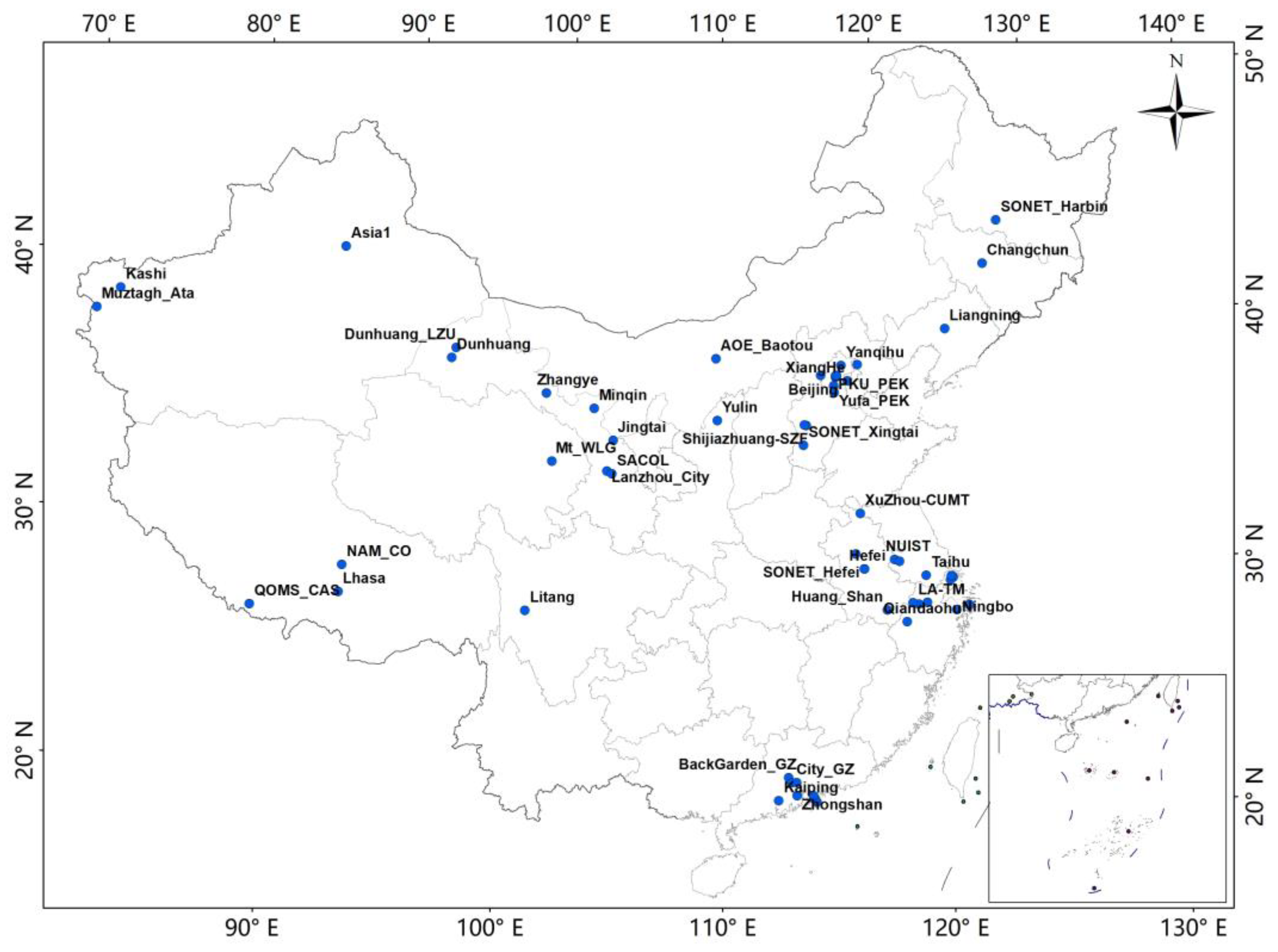
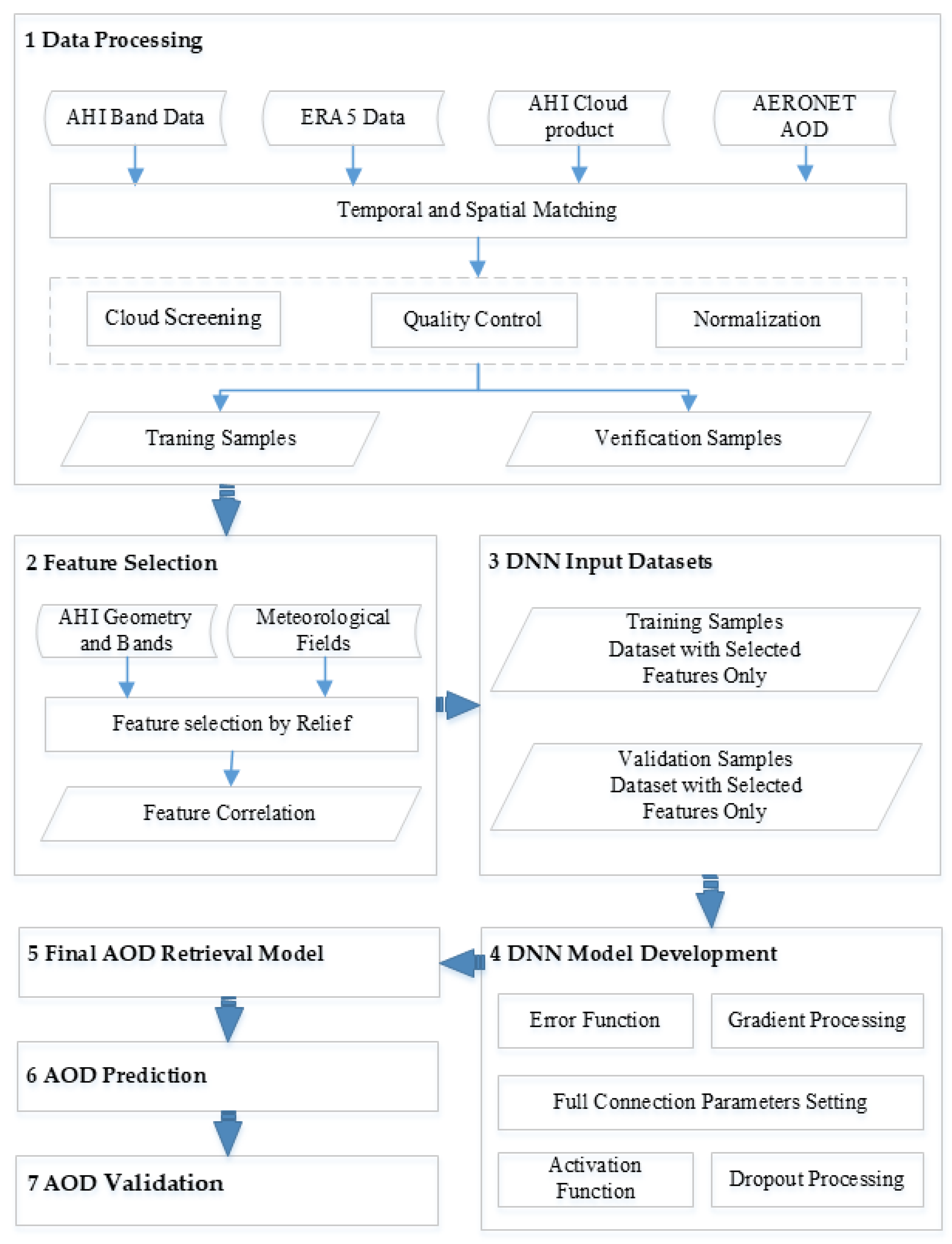
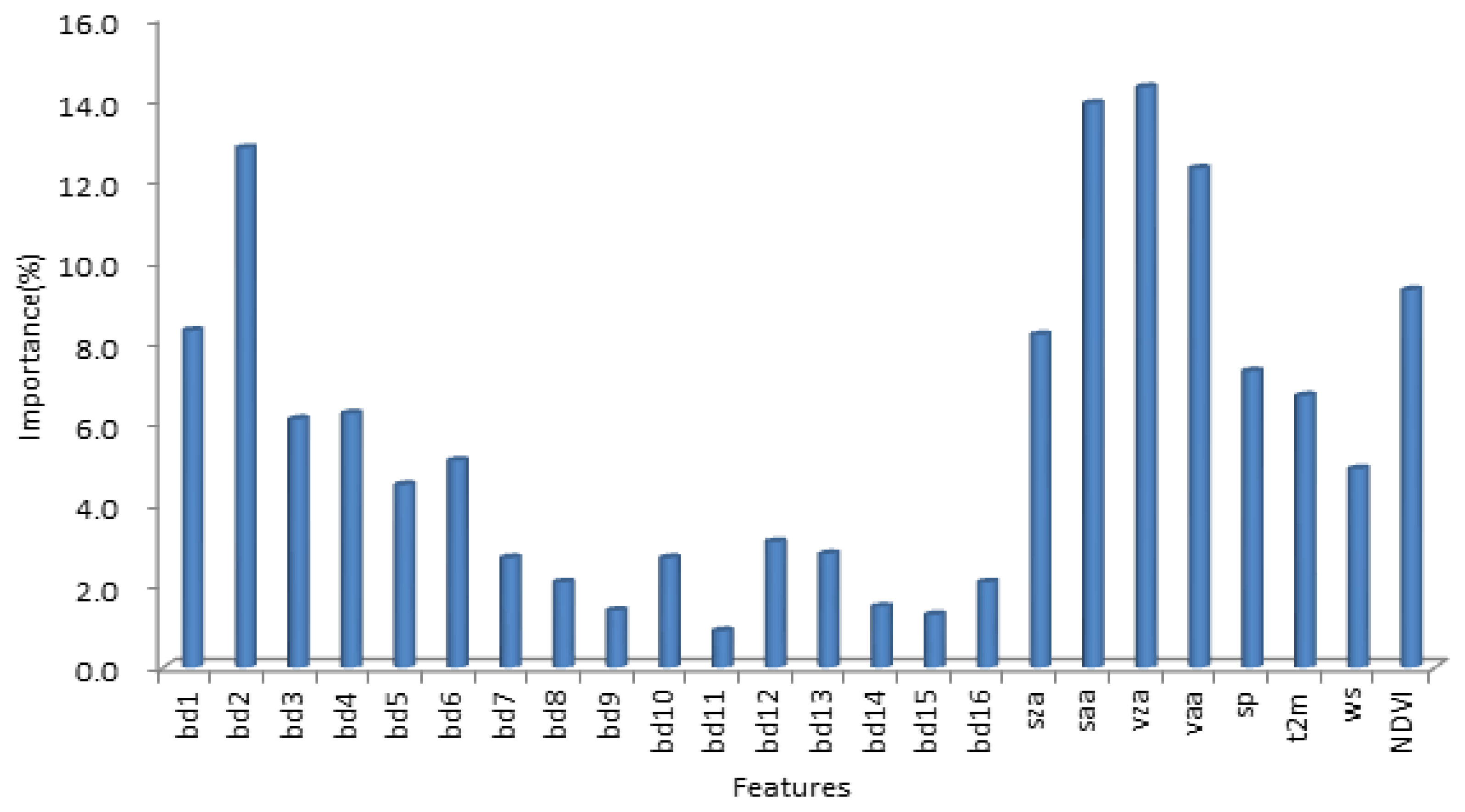
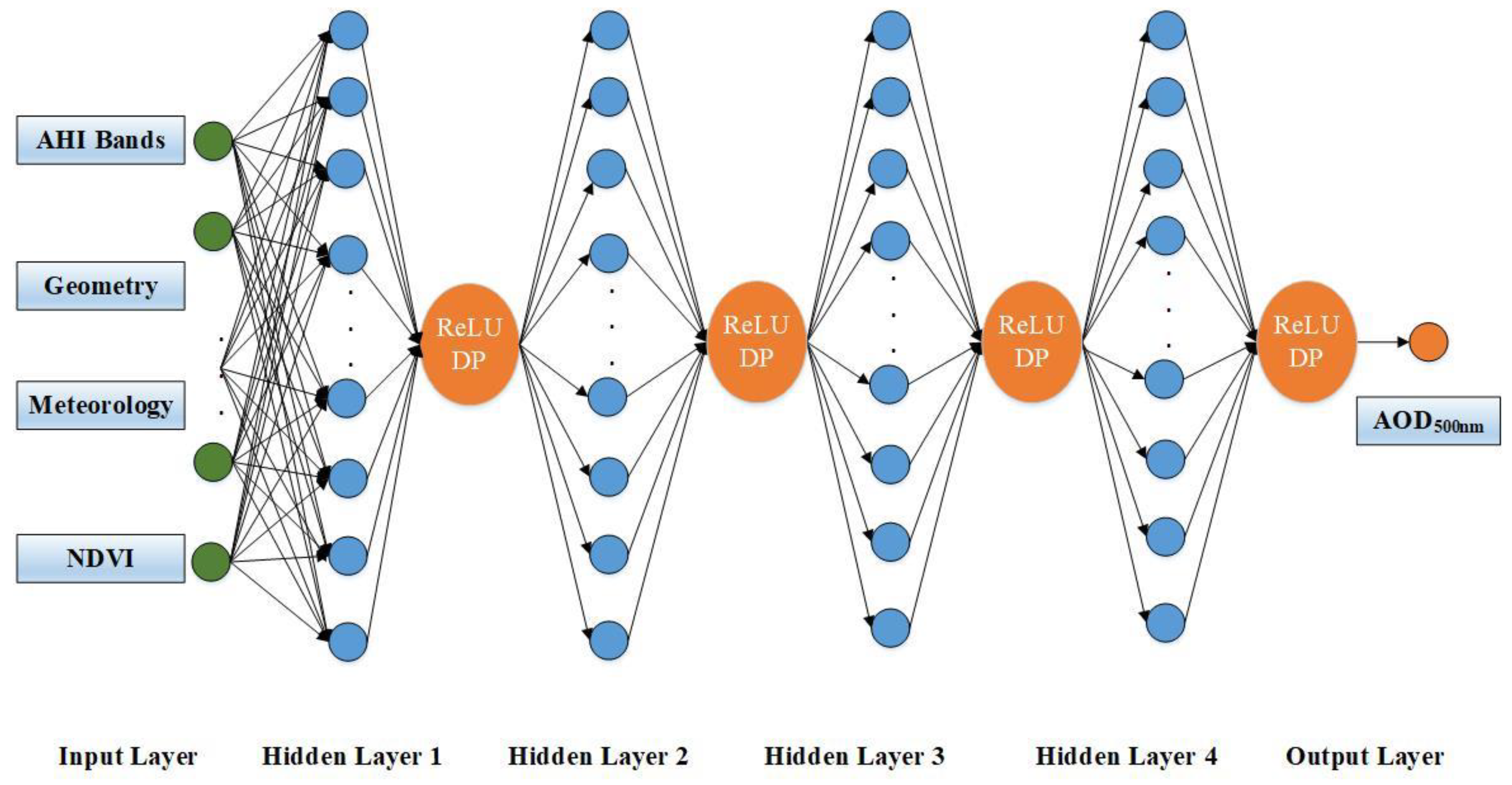







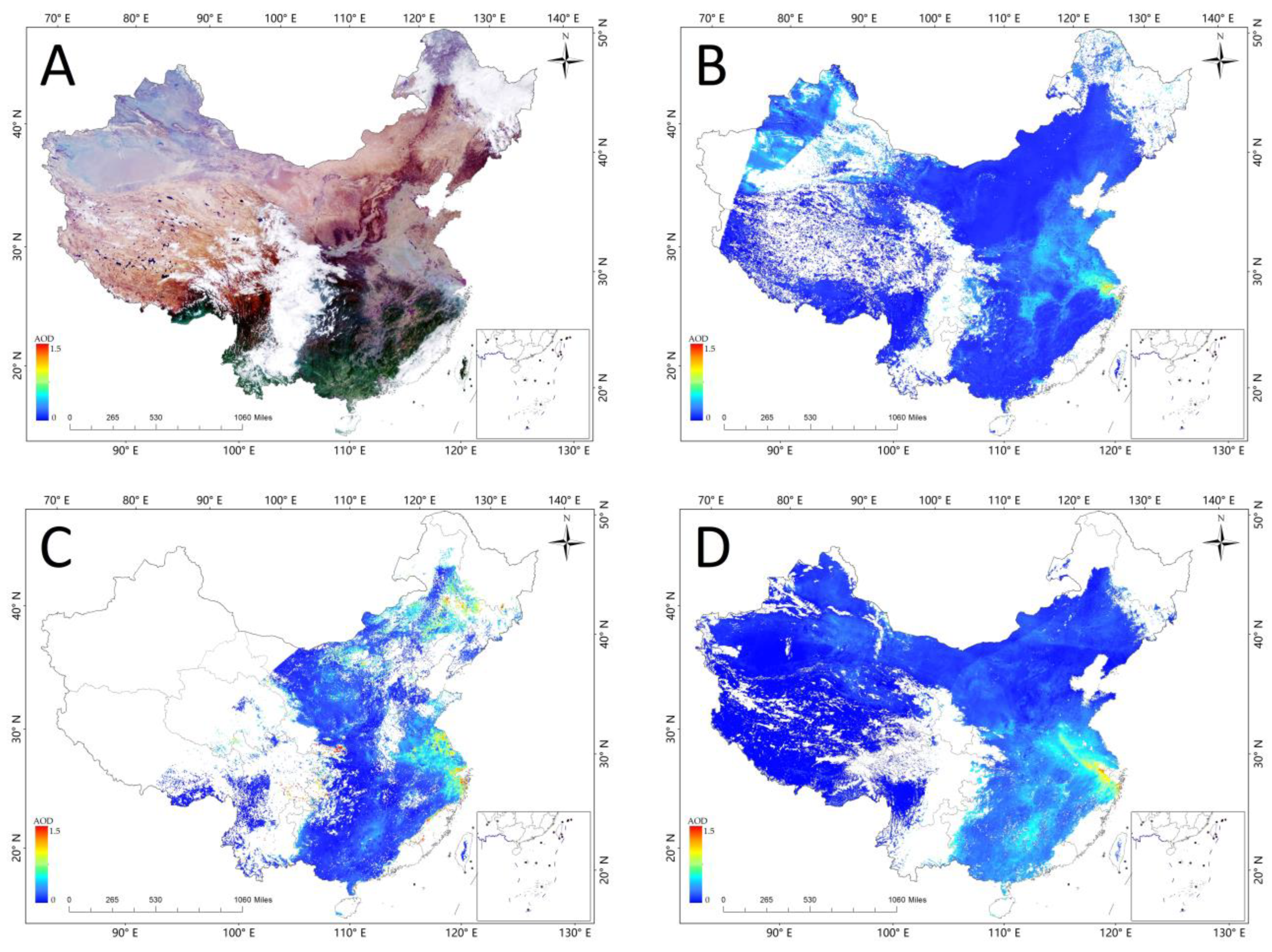

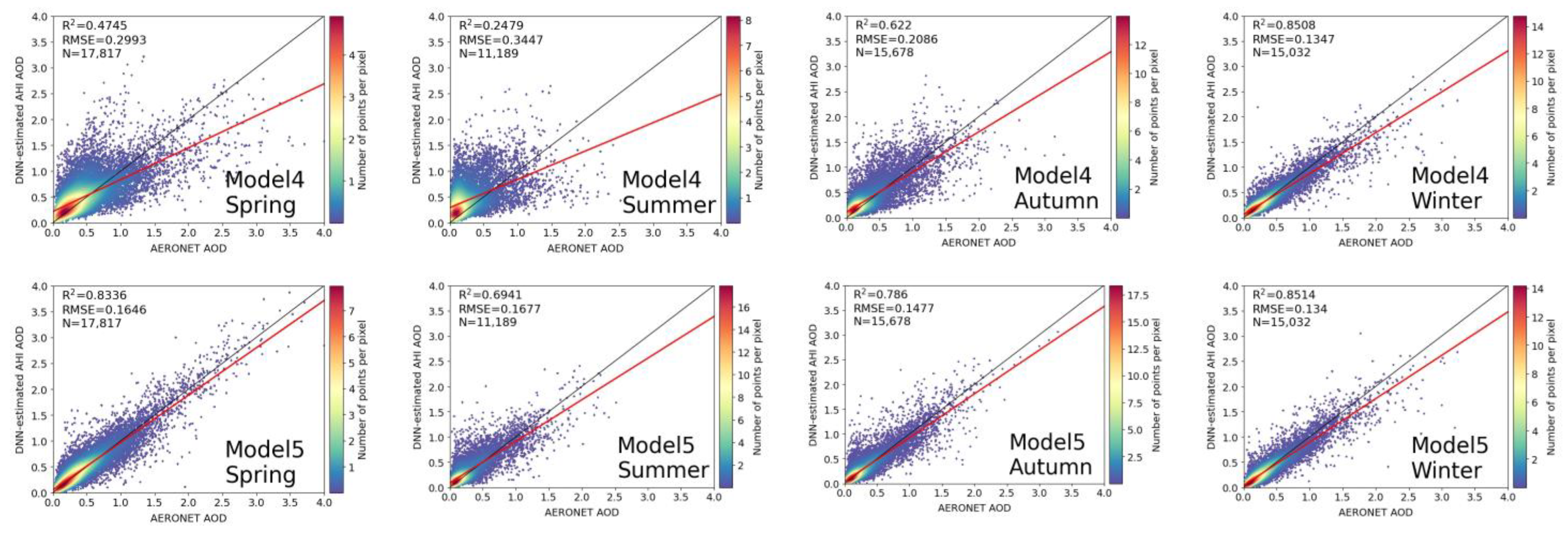


| AOD Product | Bands (nm) |
|---|---|
| AERONET AOD | 1640, 1020, 870, 865, 779, 675, 667, 620, 560, 555, 551, 532, 531, 510, 500, 490, 443, 440, 412, 400, 380, 340 |
| MODIS AOD | 470, 550 |
| Himawari-8 AOD | 500 |
| Band | Wavelength (μm) | Spatial Resolution (km) | Band | Wavelength (μm) | Spatial Resolution (km) |
|---|---|---|---|---|---|
| 1 | 0.46 | 1 | 9 | 7.0 | 2 |
| 2 | 0.51 | 1 | 10 | 7.3 | 2 |
| 3 | 0.64 | 0.5 | 11 | 8.6 | 2 |
| 4 | 0.86 | 1 | 12 | 9.6 | 2 |
| 5 | 1.2 | 2 | 13 | 10.4 | 2 |
| 6 | 2.3 | 2 | 14 | 11.2 | 2 |
| 7 | 3.9 | 2 | 15 | 12.3 | 2 |
| 8 | 6.2 | 2 | 16 | 13.3 | 2 |
| Model 1 R2 | Model 2 R2 | Model 3 R2 | Model 4 R2 | Model 5 R2 | Model 1 RMSE | Model 2 RMSE | Model 3 RMSE | Model 4 RMSE | Model 5 RMSE | |
|---|---|---|---|---|---|---|---|---|---|---|
| Spring | 0.8199 | 0.1227 | 0.1730 | 0.4745 | 0.8336 | 0.1712 | 0.4090 | 0.4122 | 0.2993 | 0.1646 |
| Summer | 0.4285 | 0.6850 | 0.3172 | 0.2479 | 0.6941 | 0.2643 | 0.1602 | 0.2428 | 0.3447 | 0.1677 |
| Autumn | 0.5285 | 0.5648 | 0.8002 | 0.6220 | 0.7860 | 0.2410 | 0.2395 | 0.1433 | 0.2086 | 0.1477 |
| Winter | 0.6573 | 0.3575 | 0.6638 | 0.8508 | 0.8514 | 0.2064 | 0.3476 | 0.2137 | 0.1347 | 0.1340 |
| Cases | Meteorological Factors Included | R2 | RMSE |
|---|---|---|---|
| Case 1 | sp, t2m, ws | 0.8168 | 0.1546 |
| Case 2 | sp, t2m | 0.8009 | 0.1633 |
| Case 3 | sp, ws | 0.7960 | 0.1598 |
| Case 4 | t2m, ws | 0.7781 | 0.1730 |
| Case 5 | sp | 0.7947 | 0.1615 |
| Case 6 | t2m | 0.7721 | 0.1691 |
| Case 7 | ws | 0.7431 | 0.1826 |
| Case 8 | none | 0.7394 | 0.1815 |
Publisher’s Note: MDPI stays neutral with regard to jurisdictional claims in published maps and institutional affiliations. |
© 2022 by the authors. Licensee MDPI, Basel, Switzerland. This article is an open access article distributed under the terms and conditions of the Creative Commons Attribution (CC BY) license (https://creativecommons.org/licenses/by/4.0/).
Share and Cite
Chen, Y.; Fan, M.; Li, M.; Li, Z.; Tao, J.; Wang, Z.; Chen, L. Himawari-8/AHI Aerosol Optical Depth Detection Based on Machine Learning Algorithm. Remote Sens. 2022, 14, 2967. https://doi.org/10.3390/rs14132967
Chen Y, Fan M, Li M, Li Z, Tao J, Wang Z, Chen L. Himawari-8/AHI Aerosol Optical Depth Detection Based on Machine Learning Algorithm. Remote Sensing. 2022; 14(13):2967. https://doi.org/10.3390/rs14132967
Chicago/Turabian StyleChen, Yuanlin, Meng Fan, Mingyang Li, Zhongbin Li, Jinhua Tao, Zhibao Wang, and Liangfu Chen. 2022. "Himawari-8/AHI Aerosol Optical Depth Detection Based on Machine Learning Algorithm" Remote Sensing 14, no. 13: 2967. https://doi.org/10.3390/rs14132967
APA StyleChen, Y., Fan, M., Li, M., Li, Z., Tao, J., Wang, Z., & Chen, L. (2022). Himawari-8/AHI Aerosol Optical Depth Detection Based on Machine Learning Algorithm. Remote Sensing, 14(13), 2967. https://doi.org/10.3390/rs14132967







